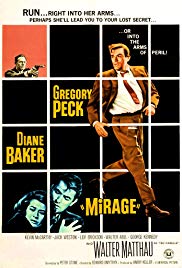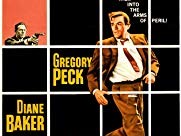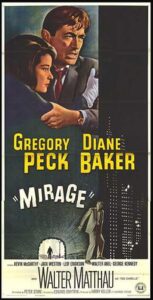Mirage **** (1965, Gregory Peck, Diane Baker, Walter Matthau, George Kennedy, Jack Weston, Leif Erickson, Kevin McCarthy) – Classic Movie Review 9,371
The 1965 neo noir chase-mystery film Mirage is a deliciously tasty, satisfyingly convoluted Hitchcockian paranoia/ amnesia/ conspiracy thriller starring a memorable line-up of Gregory Peck, Diane Baker, Walter Matthau, George Kennedy and Jack Weston.
Director Edward Dmytryk’s 1965 American neo noir chase-mystery film Mirage is a deliciously good and satisfyingly convoluted Hitchcockian paranoia/ amnesia/ conspiracy thriller starring a memorable line-up of Gregory Peck, Diane Baker, Walter Matthau, George Kennedy, Jack Weston, Leif Erickson and Kevin McCarthy.
The plot has cost accountant David Stilwell (Gregory Peck) losing his memory and his noted philanthropist and peace activist boss Charles Calvin (Walter Abel) falling from the 27th floor of the skyscraper where David works. There’s a power outage, and Stillwell decides to exit using the darkened stairs, encountering a young woman who seems to know him, but he has no recollection of her. She flees to the sub-basement, but later, when Stilwell returns to his office building, the sub-basement does not exist.
Then there’s Diane Baker as the young mystery woman called Shela, Walter Matthau as Ted Caselle, the detective Peck hires, and Jack Weston and George Kennedy as assassins. This and lots more keep the pot simmering tastily and fragrantly, with plenty of suspense and intriguingly involved, far-fetched plotting.
Joe MacDonald’s black and white cinematography looks smart, and the location filming is an attraction, but it is still a shame that the movie is not in colour, though. Quincy Jones’s score is another real asset. He composed, arranged and conducted it. The soundtrack album was released on the Mercury label in 1965.
Peter Stone’s expert screenplay is based on the 1952 novel Fallen Angel by Howard Fast [written under the pseudonym of Walter Ericson], though the novel is not credited on screen by its title. Mirage is intended and crafted as a follow-up to writer Peter Stone’s successful Charade, with its cast members Matthau and Kennedy returning here.
A happy Peck gave Stone a Rolls-Royce as a post-production thank-you gift. They went on to work on the similar Arabesque (1966) together, this time filmed in Technicolor. A later Peter Stone career highspot is his script for The Taking of Pelham One Two Three (1974), again with Matthau. In late career, Stone wrote Just Cause (1996), a thriller film starring Sean Connery.
Also in the cast are Leif Erickson, Kevin McCarthy, Robert H Harris, Anne Seymour, House B Jameson, Hari Rhodes, Syl Lamont, Eileen Baral, Neil Fitzgerald and Franklin E Cover.
Filming took place in the New York Financial District. The fictional Unidyne company is at 2 Broadway. Peck and Baker walk through Battery Park to City Pier A.
Mirage was filmed between 24 October 1964 and 24 December 1964. It is shot by Joe MacDonald on Eastman Kodak black and white film 4-X 5224. It was released on 26 May 1965 in the US. It was not as successful as Charade, but then it’s not quite as good, though it is still very smart and entertaining anyway.
Mirage is directed by Edward Dmytryk, runs 108 minutes, is made and released by Universal Pictures, is written by Peter Stone, based on the novel Fallen Angel by Howard Fast [Walter Ericson], is shot by Joe MacDonald, is produced by Harry Keller, is scored by Quincy Jones, and is designed by Alexander Golitzen and Frank Arrigo.
The cast are Gregory Peck as David Stillwell, Diane Baker as Shela, Walter Matthau as Ted Caselle, Kevin McCarthy as Josephson Jack Weston as Lester, Leif Erickson as Major Crawford, Walter Abel as Charles Calvin, George Kennedy as Willard, Robert H Harris as Dr Broden, Anne Seymour as Frances, House B Jameson as Bo, Hari Rhodes as Lt Franken, Syl Lamont as Benny, Eileen Baral as Irene, Neil Fitzgerald as Joe Turtle, and Franklin E Cover as group leader.
Edward Dmytryk in 1947 was named as one of the Hollywood Ten, blacklisted film professionals who refused to testify to the House Un-American Activities Committee during the McCarthy-era Red Scare. They were all jailed for contempt of Congress. But in 1951 Dmytryk testified to the HUAC and named people, whose careers were destroyed for many years, to resume his career.
© Derek Winnert 2020 Classic Movie Review 9,371
Check out more reviews on http://derekwinnert.com




